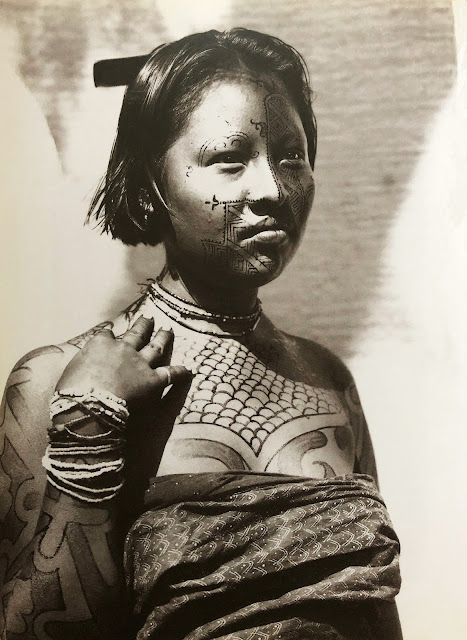BRAZIL – BRÉSIL
Brésil Musique Indienne – Collection du Musée de l'Homme – Contrepoint MC 20-137, recorded by Simone Dreyfus-Roche in 1955 (LP)
In 1955, anthropologist Simone Dreyfus-Gamelon (b. 1925) made these invaluable recordings in Brazil for the Centre National de la Recherche Scientifique and the Musée de l’Homme.
The music on this album is performed by six ethnic/cultural groups: the Kuikuro, Yawalapiti, Kamaiura, Kayapo, Gorotire and Kaingang recorded in the states of Mato Grosso, Pará and Santa Catarina. At the time of these recordings, these communities were facing the imminent loss of their ancestral lands and the disappearance of their traditional ways of life, identities, cultures, languages, and traditions.
The music here was performed in the context of traditional rituals and ceremonies, including dances (A1, A3, B2, B3, B4, B5), a mask chant (A5) and the celebration of the dead (B6, B7). With the exception of two instrumental tracks featuring pan pipes (A2) and duct flutes (A4), the music is primarily vocal, solo or collective, accompanied by exclamations, imitation of animals (B4), horns, rattles and rhythmically struck sticks.
En 1955, l'anthropologue Simone Dreyfus-Gamelon (née en 1925) a réalisé ces précieux enregistrements au Brésil pour le Centre national de la recherche scientifique et le Musée de l'Homme.
La musique sur cet album est interprétée par six groupes ethniques/culturels : les Kuikuro, les Yawalapiti, les Kamaiura, les Kayapo, les Gorotire et les Kaingang enregistrée dans les états du Mato Grosso, du Pará et de Santa Catarina. À l'époque de ces enregistrements, ces communautés étaient confrontées à la perte imminente de leurs terres ancestrales et à la disparition de leurs modes de vie, de leurs identités, de leurs cultures, de leurs langues et de leurs traditions.
Ces musiques ont été jouées dans le contexte de rituels et de cérémonies traditionnels, notamment des danses (A1, A3, B2, B3, B4, B5), un chant de masque (A5) et la célébration des morts (B6, B7). A l'exception de deux plages instrumentales avec des flûtes de Pan (A2) et des flûtes-à-bloc (A4), la musique est essentiellement vocale, solo ou collective, accompagnée d'exclamations, d'imitations d'animaux (B4), de cornes, de hochets et de bâtons frappés rythmiquement.
A1 – Anduvé dance – Kuikuro people (Mato Grosso)
A2 – Pan pipes – Yawalapiti & Kamaiura people (Mato Grosso)
A3 – Awarau dance – Yawalapiti people (Mato Grosso)
A4 – Duct flutes – Yawalapiti people (Mato Grosso)
A5 – Kwahahalu mask chant – Yawalapiti people (Mato Grosso)
A6 – Ihaha women’s choir – Yawalapiti people (Mato Grosso)
B1 – Mekrakaroré chant – Kayapo people (Pará)
B2 – Mekrakaroré dance – Kayapo people (Pará)
B3 – Kurukango dance in a circle and in a single file – Kayapo people (Pará)
B4 – Kozi-Kozi monkey dance – Yawalapiti people (Mato Grosso)
B5 – Kurukango dance – Gorotire people (Pará)
B6 & B7 – Celebration of the dead – Kaingang people from Chapeco (Santa Catarina)
Download:
Many thanks to Julien for sharing this album!
Our other posts of indigenous music from South America:
Indiens et Animaux Sauvages d’Amérique du Sud – UNIDISC here
The Indians of Colombia – Lyrichord - LLST 7365 here
Wayapi Guyane – SELAF-ORSTOM CETO 792 here
The Music of Primitive Man – Horizon – P 11857 here
Photographs below are from L’Amazonie Disparue: Indiens et Explorateurs 1825-1930 by Antoine Lefébure, published by La Découverte, 2005, and Encyclopaedia Universalis France, 1988:
A young Kadiwéu woman with tattoos, photographed
by Guido Boggiani, 1897:
A young Kayapo (B1, B2, B3) boy photographed by Sue Cunningham:







%205%2058.jpg)
%20P%2023%2031.jpg)
%20-5%2031.jpg)
%20-5%2031.jpg)


